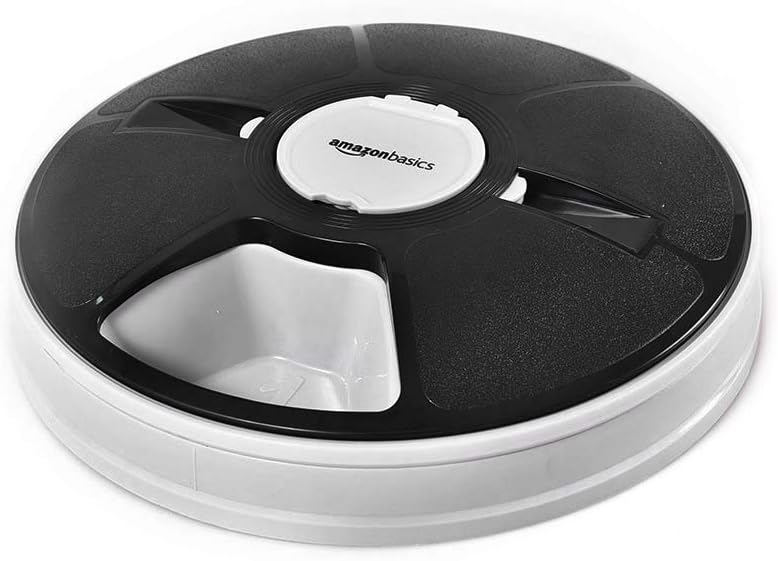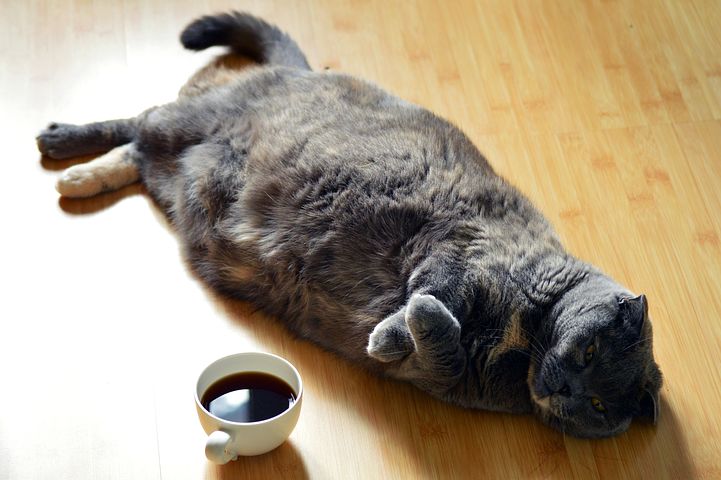Weight Loss in Cats Is Not That Hard, But Be Careful
The feeder you need to help cats lose weight. https://amzn.to/3sHabB4
A valuable article on Automatic Feeders entirely
Weight Loss In Cats
Cats will sit by the machine and wait to be fed. They don’t keep coming to you “I’m hungry” “I’m hungry” because now, a device feeds them.
Weight loss in cats should be gradual because if the weight comes off TOO FAST, a cat might develop a condition called “hepatic lipidosis” which is explained HERE.
If you have more than one cat you can ALMOST hang it up as hopeless, unless you can keep their feeding fastidiously separate. This really is a problem.
If your cat decides to harass you for food, you’ll probably give up, too. I get that. But there’s a way around it. One of the ways to stop the cat from bothering you for food when you “cut back” is to get an automatic feeder WITH PORTION CONTROL. That’s hard to get nowadays.
What they have now is a feeder that dispenses “about” 7 grams of food. So if you want your cat to get 14 grams in the morning and 14 grams at night you have to feed the cat twice in the morning and twice at night because it only dumps 7 grams at a feeding. The better results are had when you can actually measure the food but have SOMEONE (or SOMETHING) else actually give it to the cats.

So instead of the automatic feed DUMPERS, there are the SECTIONAL premeasured feeders. Here’s a picture and a link to the feeder people find the MOST successful for weight loss in cats. It’s also a lot cheaper than the WIFI ones.
WHY DOES A SECTION FEEDER WORK BEST?
What happens is that you create “six degrees of separation” between YOU and the feeding. Over time, the cats don’t “know” that bothering you for more food will work because “you” no longer feed them. They actually pester the machine.
Cats will sit by the machine and wait to be fed. They don’t keep coming to you “I’m hungry” “I’m hungry” because now, a device feeds them.

With significant obesity, these cats are at risk of developing “Fatty Liver Syndrome”, also known as “Hepatic Lipidosis” (by folks on my side of the table). Additionally, it is the natural and logical consequence of a life time of obesity for a cat to become diabetic.
Unlike dogs, you cannot always safely put overweight cats on a hardcore diet.
If you have a cat over 14 pounds that has been examined by a veterinarian and he has told you the pet is indeed obese, and has determined by careful physical examination that the pet is basically healthy and able to withstand a diet, here are some things you can do:
1. Feed Hill’s W/D diet or Hill’s R/D diet. There are canned and dry forms available.
- W/D is primarily a urinary acidifying diet, but will not harm normal cats.
- R/D is Hill’s hardcore diet food for the really obese cats. It works very well, but many times the cats just won’t eat it.
The key is this: The cat MUST eat!
Fat cats that go “cold turkey” when dieted are at great risk to develop Hepatic Lipidosis. It is for this reason that I do not even recommend “dieting” for cats that may only be as little as 3-4 pounds over ideal body weight!
2. Increase exercise for the cat by attempting to take the cat for walks around the yard. There are cat leashes and harnesses available that mature cats may tolerate well.
3. Never give the cats treats or scraps. These are the ultimate sabotage for any dieting effort.
4. Feed the primary caloric load in the morning only. Then, if the cats appear hungry in the evening, instead of fasting them, which may be hazardous, offer them a smaller portion of the same dietary food. If you use an automatic feeder, pre-measure the recommended amount of food and open one meal per day and let the cat have that. Do not refill. Do not give more food during the day. With this, “grazing” is okay if it’s a limited quantity by day’s end.
5. Hepatic Lipidosis can be prevented in some cases by the concurrent administration of a multi vitamin, but especially Vitamin B complex. There are several excellent cat vitamin tablets available, and any cat on a diet should receive a multi-vitamin twice daily to hopefully prevent Fatty Liver.
If you want your cat to safely lose weight, then you will leave here with the following intentions:
Plans to feed W/D diet, without supplemental scraps and treats, in the morning only (if possible), with twice daily walks, and a vitamin 2 x D.
That sounds so simple. But first, you really need to be sure the cat is worth dieting. A cat only carrying a few pounds extra is really not a candidate for the kind of serious weight loss we are discussing here.
Download: Weight loss in cats. (Click)
It’s not THAT hard.

 Cats “blame” the machine for their hunger and stop bothering you for food. If you let the feeder do all the work.
Cats “blame” the machine for their hunger and stop bothering you for food. If you let the feeder do all the work.





